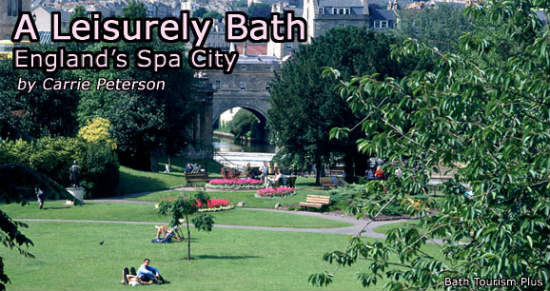

Planning to Visit the English Countryside
After three days in London, I wanted to see some of the romantic English countryside I’d read about in novels. So I paged through my travel guide, went to an Internet café, and booked a hostel and train tickets for Bath.
The next morning, the train left Paddington Station and traveled west across the beautiful fields of England.
Bath felt like scented oil after the abrasion of the capital, as I was met an hour-and-a-half later with a chorus of bird songs and green all around.
Beautiful Bath
Beneath the modern lacquer of novelty shops and the hum of tourists, Bath is still a place of serenity and charm.
Its airs of historical nobility and fine culture are as present as the modern buses and tour guides that bustle along the stone streets.
Romans created baths here in approximately A.D. 43 out of natural hot mineral springs. The baths then decayed for centuries until they were rediscovered during Queen Victoria’s reign.
For many more centuries, Bath became a holiday destination for royalty and aristocrats, who were pampered as they gossiped, flirted and gambled.
Beau Nash, who is buried in the nave of the Bath Abbey (a medieval church begun in 1499), was a well-known social peacock during the 18th century, a pompous man of wealth and flashy style who liked to be carted about the city in a sedan chair.
During this period Bath was the most fashionable spa in Britain, in part, through the efforts of architect John Wood the Elder and his son, John Wood the Younger, who designed the city using stones from the nearby hills.
They developed the landscaped terraces and Palladian villas, creating one of the most architecturally harmonious cities in England.
My Hostel
Upon checking into my hostel, I headed downtown, where I strolled through compact lanes filled with cafés and shops.
I found a classic British diner, where I sat outside to watch people chatting and window shopping in the warm evening glow.
A good English meal can be found at Sally Lunn’s House on North Parade Passage, where visitors have been supping for more than 300 years, or at a variety of eating-and-drinking stablishments, including The Bathtub Bistro, The Pump House, The Moon nd Sixpence and The Hole in the Wall.
Enjoying My Day

As dusk settled in I wandered north of the city center to the River Avon.
Turning aside to follow a canal, I passed men in their boats drinking inside smoky hulls, doing repairs or barbecuing on the banks with their families.
The day melted into darkness, and I left the canal to work my way through tangled streets to my hostel.
The fortune of this city has always been linked to its hot springs and tourism.
In the past it has attracted such well-known persons as Jane Austen (who included Bath in her novels Persuasion andNorthanger Abbey), Charles Dickens, William Thackeray and Australia’s founding father Admiral Arthur Phillip.
The modern tourists who flock here will find an array of accommodations to suit their fancies and wallets, from the beautifully restored Bath Spa Hotel to the modestly priced St. Christopher’s Inn.
This boasts a picturesque view of the street from the second-story rooms and a rousing pub at floor level.
As I left Bath Spa Train Station a few days later, I carried with me a treasury of memories: afternoons punting on the Avon with new friends; wandering the residential streets; watching street performers; licking ice cream in the summer heat; and evenings sampling Pimm’s in a quiet pub or joining the throngs of vacationers in their merrymaking.
Slipping along the rails passing through green pastures, I felt I had discovered a special place — one that had been found before by so many, and would continue to be enjoyed by so many more.
If You Go
Bath Tourism
- The Low-Key Magic of Ghent, Belgium - April 22, 2024
- Discover the Hidden Charm of Extremadura in Spain - April 20, 2024
- Life of a Champion: Exploring the Muhammad Ali Center in Louisville - April 19, 2024
